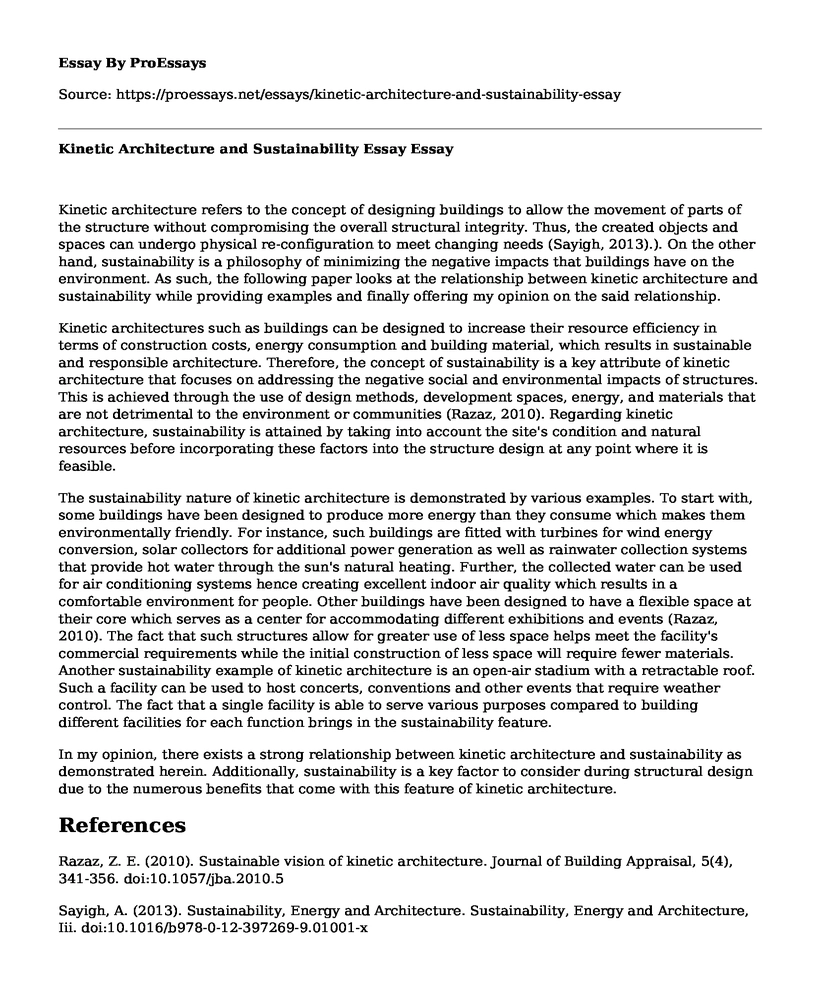Kinetic architecture refers to the concept of designing buildings to allow the movement of parts of the structure without compromising the overall structural integrity. Thus, the created objects and spaces can undergo physical re-configuration to meet changing needs (Sayigh, 2013).). On the other hand, sustainability is a philosophy of minimizing the negative impacts that buildings have on the environment. As such, the following paper looks at the relationship between kinetic architecture and sustainability while providing examples and finally offering my opinion on the said relationship.
Kinetic architectures such as buildings can be designed to increase their resource efficiency in terms of construction costs, energy consumption and building material, which results in sustainable and responsible architecture. Therefore, the concept of sustainability is a key attribute of kinetic architecture that focuses on addressing the negative social and environmental impacts of structures. This is achieved through the use of design methods, development spaces, energy, and materials that are not detrimental to the environment or communities (Razaz, 2010). Regarding kinetic architecture, sustainability is attained by taking into account the site's condition and natural resources before incorporating these factors into the structure design at any point where it is feasible.
The sustainability nature of kinetic architecture is demonstrated by various examples. To start with, some buildings have been designed to produce more energy than they consume which makes them environmentally friendly. For instance, such buildings are fitted with turbines for wind energy conversion, solar collectors for additional power generation as well as rainwater collection systems that provide hot water through the sun's natural heating. Further, the collected water can be used for air conditioning systems hence creating excellent indoor air quality which results in a comfortable environment for people. Other buildings have been designed to have a flexible space at their core which serves as a center for accommodating different exhibitions and events (Razaz, 2010). The fact that such structures allow for greater use of less space helps meet the facility's commercial requirements while the initial construction of less space will require fewer materials. Another sustainability example of kinetic architecture is an open-air stadium with a retractable roof. Such a facility can be used to host concerts, conventions and other events that require weather control. The fact that a single facility is able to serve various purposes compared to building different facilities for each function brings in the sustainability feature.
In my opinion, there exists a strong relationship between kinetic architecture and sustainability as demonstrated herein. Additionally, sustainability is a key factor to consider during structural design due to the numerous benefits that come with this feature of kinetic architecture.
References
Razaz, Z. E. (2010). Sustainable vision of kinetic architecture. Journal of Building Appraisal, 5(4), 341-356. doi:10.1057/jba.2010.5
Sayigh, A. (2013). Sustainability, Energy and Architecture. Sustainability, Energy and Architecture, Iii. doi:10.1016/b978-0-12-397269-9.01001-x
Cite this page
Kinetic Architecture and Sustainability Essay. (2022, May 12). Retrieved from https://proessays.net/essays/kinetic-architecture-and-sustainability-essay
If you are the original author of this essay and no longer wish to have it published on the ProEssays website, please click below to request its removal:
- Film Analysis Essay on It's a Wonderful Life
- Essay Sample on Good Etiquette on Social Media
- Black Magic and Symbolism in Southeast Asia Fashion Designs
- Essay Sample on Social Media: Globalization's Engine - Impact of 4th Industrial Revolution
- Essay Sample on Celebrities: Mirrors of Our Society
- Symbolism and Perspective Essay
- Essay on Social Media in the Workplace: How Employers Can Guide its Use







